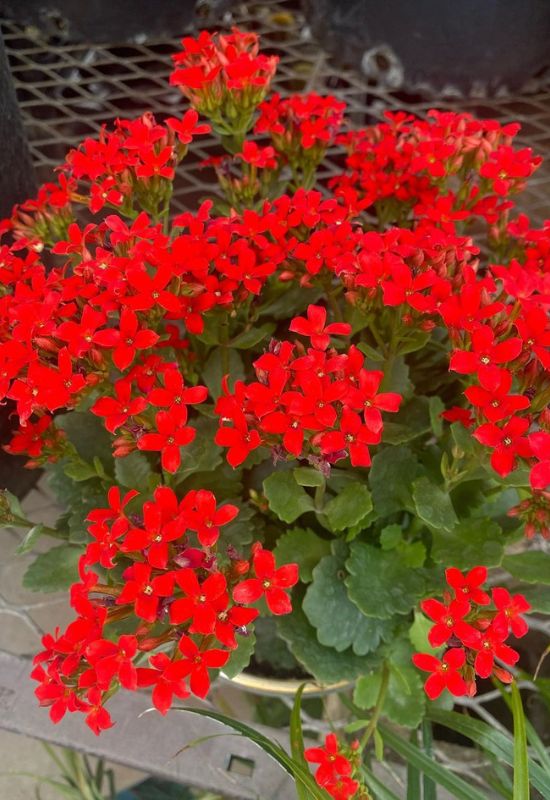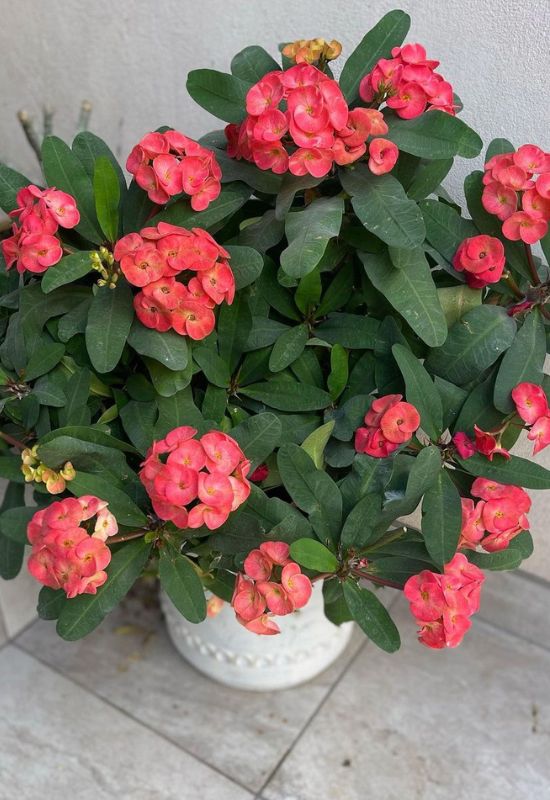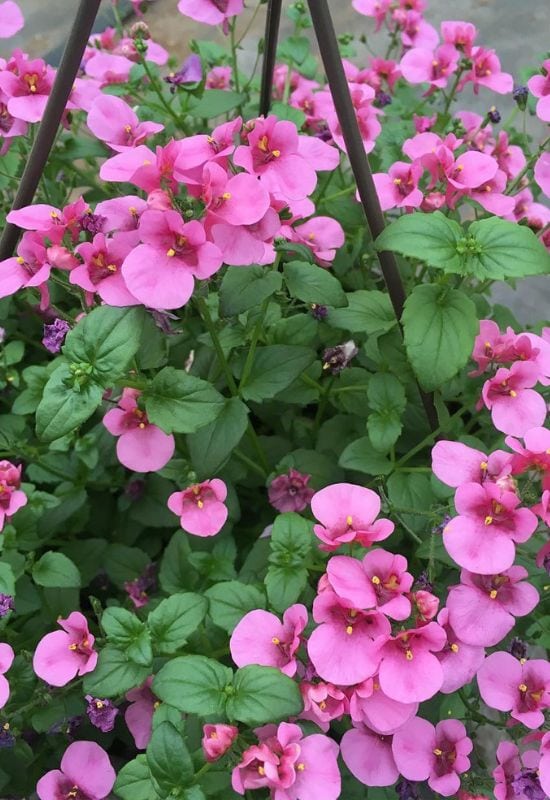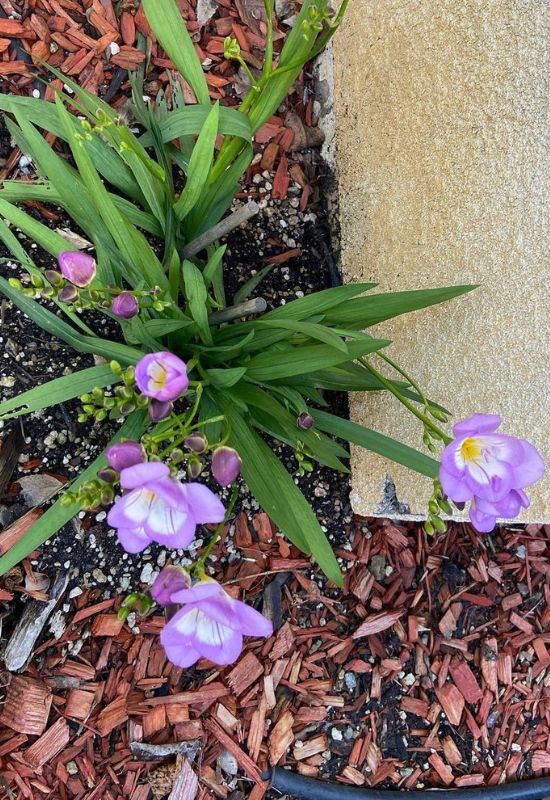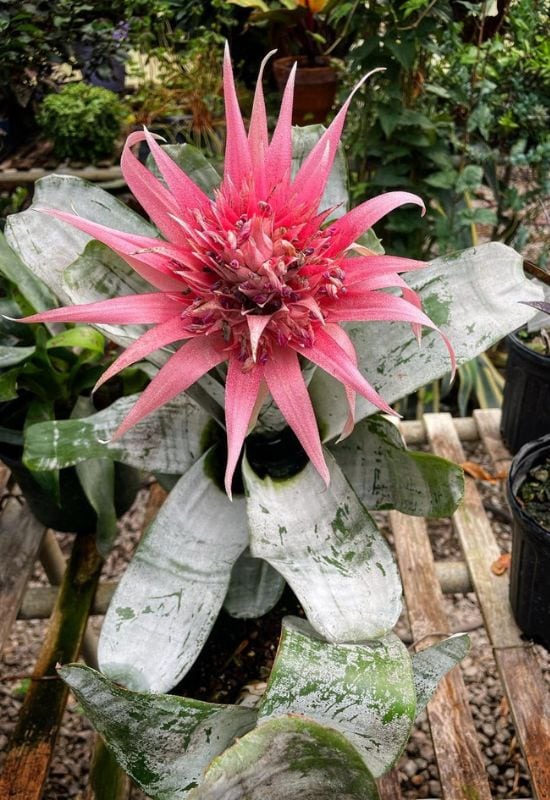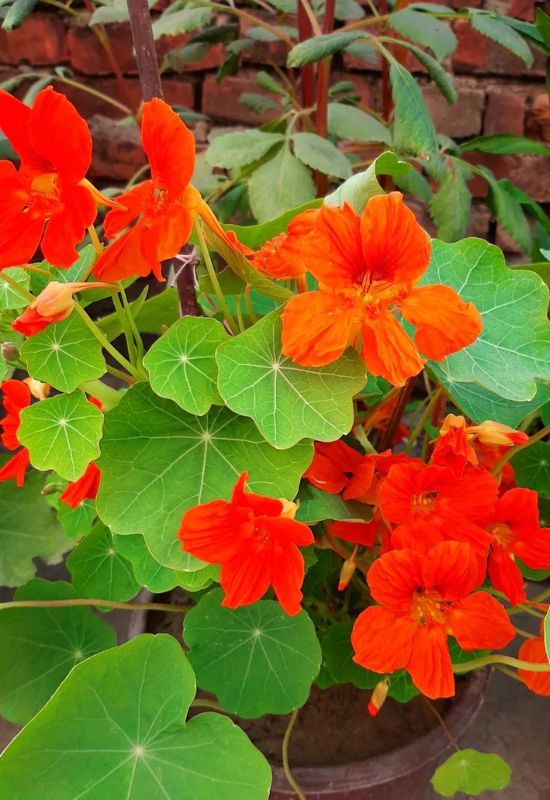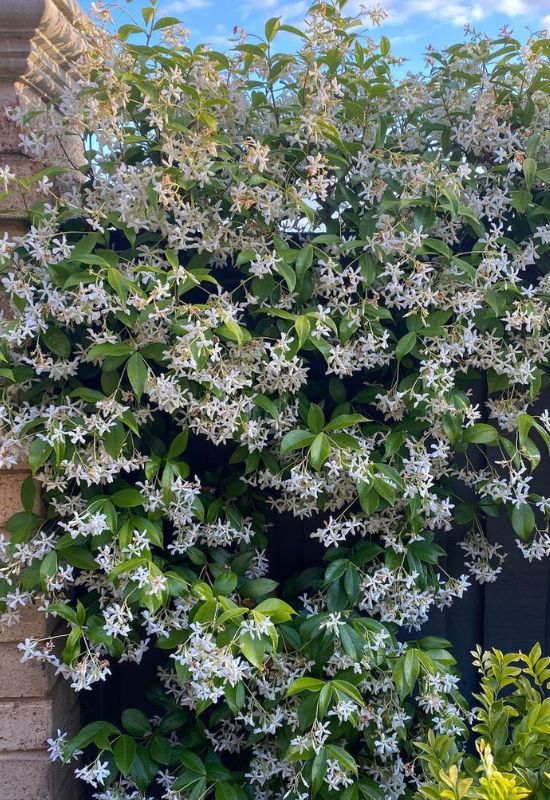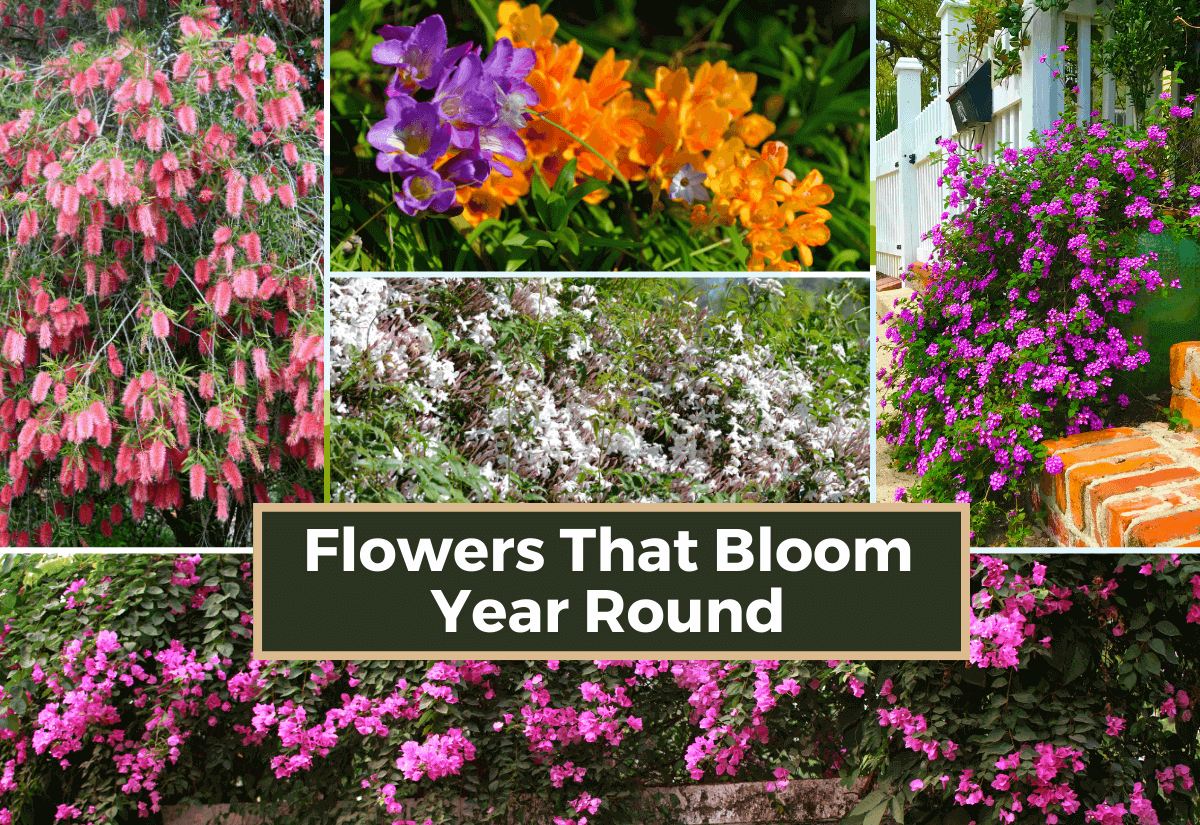
Spring is the season of flowers, and you won’t have any problems filling your garden with colorful blossoms in April, May, or summer too, and even into late fall.
But how about a garden that blooms all year round?
Why should your beds and borders look sad and forlorn in winter, for example? “Because few varieties blossom at that time,” you may answer.
And you would be right, but some plants can bloom at any time, from spring through summer to fall and even in winter, depending on where you live.
Grow perennials or shrubs that blossom from January to December, and your green haven will always look alive, alight, and flourishing!
What’s more, flowers that bloom all through the year will give your landscaping a sense of continuity through the season, as well as a constant burst of colors and scents throughout the 365 days a year.
While it’s true that many of these all-year-round flowering varieties thrive in warm weather, let’s face it, not all of us are lucky enough to live in the perfect climate for a never-ending burst of bloom.
However, you can still enjoy their continuous blooms by growing them indoors, even if you live in colder regions.
If you’re looking for the best flowers that bloom throughout the year, this roundup of champions of marathon floral displays is all you need to begin.
Our list includes annuals, perennials, and flowering shrubs for a large selection of locations and gardening styles, so you can find some favorites, no matter where they live.
20 Stunning Year-Round Bloomers That Keep Your Garden Colorful All Year
There are not many plant varieties that can really blossom any time of the year, but we found quite a few for you.
Some of these will literally keep going no stop for 12 months, others may take some breathers, but all of them can be in bloom at any day of the year, from Christmas to the Summer Solstice and beyond… Let’s meet first, then!
Here are 20 flowering plants to consider if your goal is to create an ever-blooming garden that will bloom continuously throughout all 12 months of the year.
1: Flaming Katy (Kalanchoe blossfeldiana)
Let’s start with humble (and cheap) flaming Katy… It belongs to the super strong and vigorous kalanchoe genus and in fact it is also called “Christmas kalanchoe” because at that time of the year, it is in full bloom… But it will never stop!
Smaller floral displays will keep coming through the four seasons, and you will never be left without its bright colors, including yellow, white, pink, rose, orange and fiery red! The round blossoms will appear on round umbels that display them to the sky and Sun, and there are both single and double varieties.
It is indeed a very popular houseplant but also a garden perennial in warm regions, where it is still often gown in containers. And in fact, it has won the most coveted garden prize of all, the Award of Garden Merit by the Royal Horticultural Society!
Its evergreen and succulent leaves are scalloped in shape and very lush, and of a glossy and bright green tonality, quite attractive on their own, actually.
Flaming Katy is a small succulent with a lot of energy indeed! It will provide all year round color and blossoms in flower beds, containers and rock gardens or in containers, especially if you want to shelter it over winter because you don’t live in a hot country. And it is a classic of Mediterranean gardens!
2: Golden Trumpet (Allamanda cathartica)
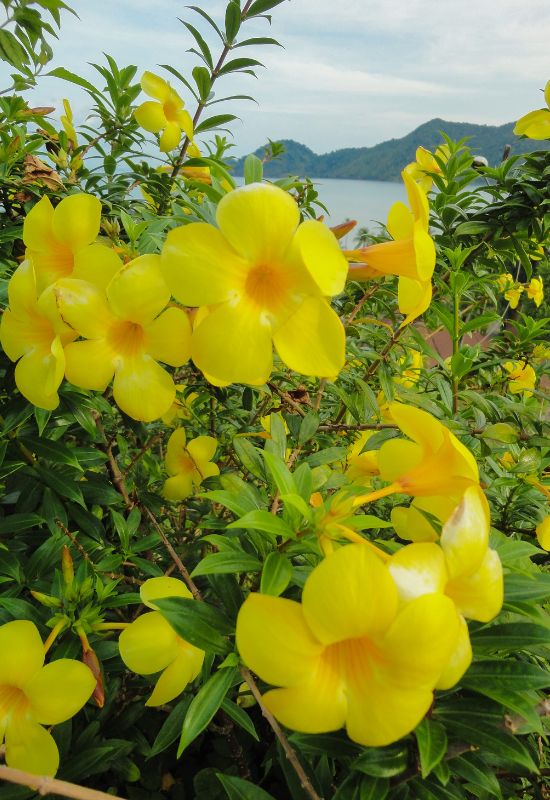
Native of Brazil, golden trumpet is a shrubby climber with a light of its own… This is due to the super luminous color of its trumpet shaped blossoms: bright yellow and glossy! And they come in great numbers all over the plant and, of course, all year round!
What is more, each blossom is big, up to 5 inches across (12.5 cm) and it opens to 5 round and showy petals… and they are sweetly fragrant as well! You may see darker markings in the throat of the blossoms, and if you want another color, similar is Allamanda blanchetii, which offers you purplish rose instead…
Both have rich green, elliptical leaves and they need to be trained onto trellises to keep upright. Otherwise, you can have these marathon bloomers as shrubs, and they will still grace your garden through the seasons.
Golden trumpet is definitely a great choice if you want your pergola, arbor or trellises to be in bloom and brightly colored all year round, or in hedges and at the back of large birders as a shrub, but thus variety and her sister need hot climate…
3: Bougainvillea (Bougainvillea spp.)
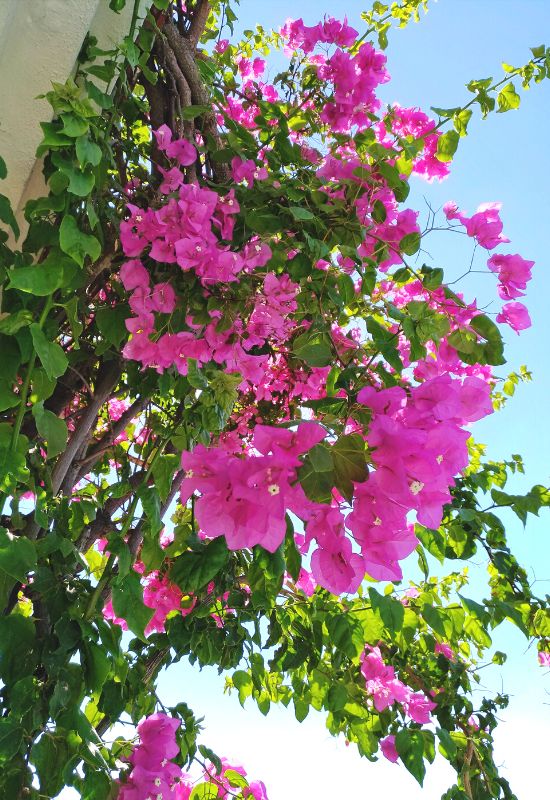
If you live in a warm country, you can literally have huge “walls” of massive and super colorful blooms all year round, and if you have visited the Mediterranean, you will know what I am talking about… Super vigorous and strong, bougainvilleas are impressive evergreen climbing shrubs that literally cover with blossoms and they do it all year round. At times, you won’t even be able to see the foliage, at others, the floral displays will be less dense, but still.
Actually, to be honest, they actual flowers are tiny and cream colored, but they are surrounded by three bracts of the most vibrant tonalities, for example magenta (quite common) like with ‘Helen Johnson’. Or if you want dark yellow, grow ‘California Gold’; for fiery red, you can choose ‘San Diego Red’.
But for a more delicate effect, you can even pick ‘Imperial Delight’, with white and pink… The glossy leaves are deep green, pointed, and quite attractive – when you can actually see them, that is.
Some bougainvillea varieties can grow into real giants, but there are also dwarf ones if you don’t have a vast space for it to fill with its massive blooms.
Of course, it is ideal to cover whole walls (even whole buildings), on strong pergolas and harbors, or to create a natural fence, as, being thorny, it will keep intruders away… Of course, it is a must have in any Mediterranean garden.
4: Crown of Thorns (Euphorbia milii)
Also called Christ plant, crown of thorns has a religious theme… Well, the idea is that the strange looking blossoms which continue all through the year and the thorns on the branches give an idea of the Passion of Jesus… But let’s unravel this mystery…
The flowers we see are not actually flowers… They are the two bright red and bean shaped bracts that surround the actual small blossoms, and they last for ages…
Its succulent stems are grayish in color and they look quite ancestral, even menacing, but they are actually soft and succulent and they form shrubs with an open habit, with a wild but colorful personality.
Yes, because on top of the never ending floral display, the long ovate and glossy evergreen leaves will offer you emerald shades from bright to dark most of the time, but – as winter approaches- they will blush to rose, reddish and even purplish…
This slow growing bushy and spiky native of Madagascar has also won the Award of Garden Merit by the Royal Horticultural Society!
Yet again, crown of thorns needs a very warm climate to thrive outdoors, where it can spark up flower beds, borders or rock gardens all year round.
However, many people like to have it in containers, so you can shelter it in winter or even have it as a houseplant. And yet again, this is a classic of Mediterranean gardens.
5: Lantana (Lantana spp.)
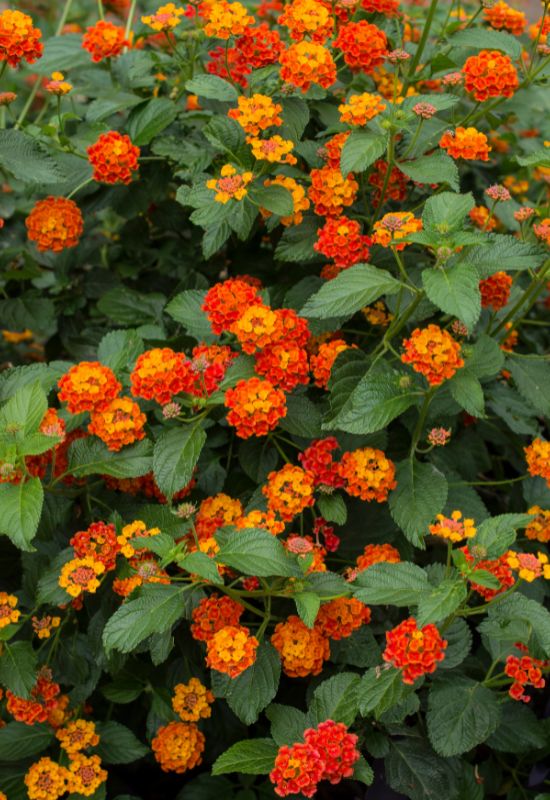
Here is a puzzling flowering shrub for all the seasons for you and your garden: lantana… Yes, because it produces round inflorescences with many sweet looking small little flowers in them, and in warm climates it will do it in spring, summer, fall and winter… Non stop!
But this is not the only strange behavior of this Central and South American native beauty… No… You will notice that within the same clusters, all the little blooms have different colors!
There are some that have just one, but most mix and match shades of yellow, white, orange, red and pink… And the different varieties are usually divided according to the combination…
All however are really loved by butterflies, bees and other pollinators, and they offer a source of food also when it is hard to find it… The evergreen foliage is very dense and it forms a mound of dark green, semi glossy, pointed and serrated leaves.
Very easy to grow, lantana can be a medium sized shrub but there are also many dwarf cultivars, so you can even have it in a small garden or in containers.
On wall sides, in borders and hedges, and on banks and slopes it provides kaleidoscopic colors all year round, especially in coastal and Mediterranean gardens, but it’s suitable for all traditional styles.
6: Bird of Paradise (Strelitzia reginae)
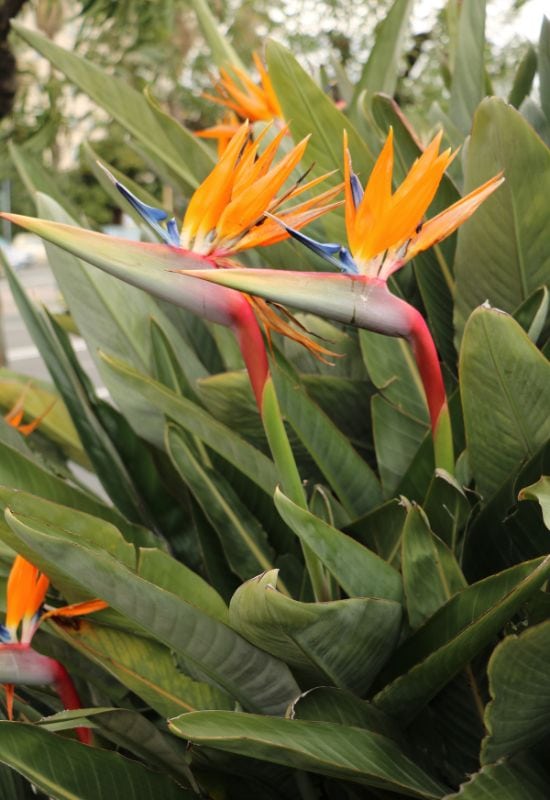
One of the most exotic looking flowering perennials ever, known as bird of paradise or by its scientific name, Strelitzia,isa native wonder from South Africa. Once again, it likes hot climates, but it can blossom all year round.
True, in many cases, it skips the warm months of summer, but if the weather is fresh enough or if it grows in part shade, it can flare up with is incredible floral displays even during this time… And it is spectacular!
It is so called because the flowers look like colorful birds with spread out wings… To start with, they can reach 12 inches in length (30 cm)!
Next, they are very glossy and waxy, with a luminous sheen… And you will see the brightest shades of orange, purple, magenta, violet and blue on these amazing blooms!
Don’t forget that they are literally oozing with juicy sweet nectar, and the hummingbirds literally love them! Winner of the famous Award of Garden Merit by the Royal Horticultural Society it also produced amazing leaves in deep and glossy green, rubbery in texture and lance shaped, up 3 feet long (90 cm) and holding on to super strong and big petioles – and, of course, this tropical looking foliage is also evergreen!
One of the most amazing accent perennials you can have in big and tropical looking borders, or to decorate walls and fences, bird of paradise is also one of the most sought after (and expensive) cut flowers ever. It is ideal for exotic looking designs, as a houseplant and (again) for Mediterranean gardens.
7: Twinspur (Diasciabarberae)
So far, we have only seen varieties that love very hot climates, and the reason is simple: mild winters allow them to blossom. Twinspur is a bit hardier, and a mat foring perennial from South Africa.
However, it will only blossom all year round if the cold season is mild, otherwise it may stop during the harsh months between December and February. Still, you can try it and shelter it in case…
And you will get a romantic sea of round, sweet looking and pink blossoms with broad petals and a bright rose center, in quick succession and without stopping! Look closely, and you will also notice a luminous golden yellow spot that draws your eye in and apparently, also signals to pollinators where to land to get food!
And it is hidden in two black spurs, which give this perennial its name. But if this is a secret you didn’t know, this is no surprise for pollinators, bees and butterflies… They will spot twinspurs from a distance and flood to your garden, especially when food is scarce…
Little ovate and green leaves will form a dense mound, and they will only appear when the floral display takes a little breath, because it will usually cover the whole plant.
Spreading and even draping, twinspur will work wonders in hanging baskets and containers, as ground cover and in rock gardens, where its rosy blooms will bring a sigh of romance all year round.
8: Freesia (Freesia spp.)
One of the most fragrant bulbous perennials ever, freesias can blossom all year round. But let’s be clear; it does not mean that a single plant will do it – it will need to go into dormancy and stop its sweet smelling floral display…
But you can stagger the planting and have some at any time, including in winter. Thus, the lovely funnel shaped flowers that open to broad and round petals, in bright colors of white, yellow, red, pink and violet in many shades, single or double as you wish, will open on the elegant arching stems when you prefer it.
Just plant the corns about 10 to 12 weeks before the chosen season for this burst of color and scent and you can’t get it wrong. That is, only if you live in a pretty warm country… As usual! But with the many varieties you can pick from, and their beautiful bright green blade shaped foliage, they are always worth it!
All freesia varieties are favorite cut flowers all over the world, but you can keep them in your flower beds or in containers as well, and, personally, I believe they look wonderful in rock gardens.
9: Bottlebrush (Callistemon spp.)
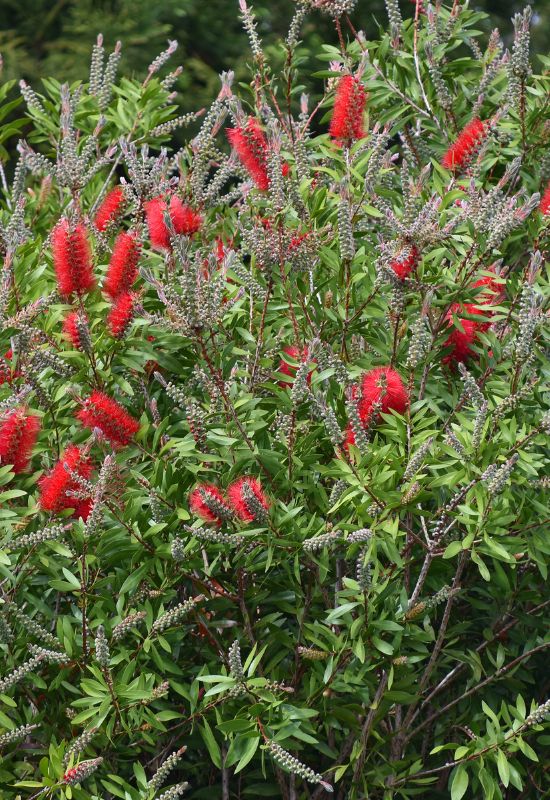
Here is another exotic beauty that never stops flowering – it is always bright and colorful all year round! And… It looks a bit “weird”… Yes, because the blooms look like bottlebrushes attached to the tips of the branches of this evergreen shrub… The name is not a mistake…
And there are a few species and varieties, so, some have longer inflorescences, some shorter. And you can also pick from a fair range of color, but all very vivid. For example, Callistemon salignusis snow white, Callistemon lineraisis bright scarlet, and Callistemon citrinushas many cultivars in different shades of pink and rose…
And if you have a small garden, you can grow a dwarf variety, like Callistemon viminalis ‘Little John’, tiny, but with very eye catching red blossoms. The foliage can be broader or thinner, according to the one you choose, but it usually looks very stiff and it is very attractive and decorative indeed, in tonalities that range from bright green to blue gray.
Once again, you will definitely need to live in a hot and dry country to grow any of the bottlebrush varieties in your garden, and in fact it is a very popular shrub (or small tree) all over the Mediterranean and in landscapes inspired to this amazing sea…
10: Flamingo Flower (Anthurium spp.)
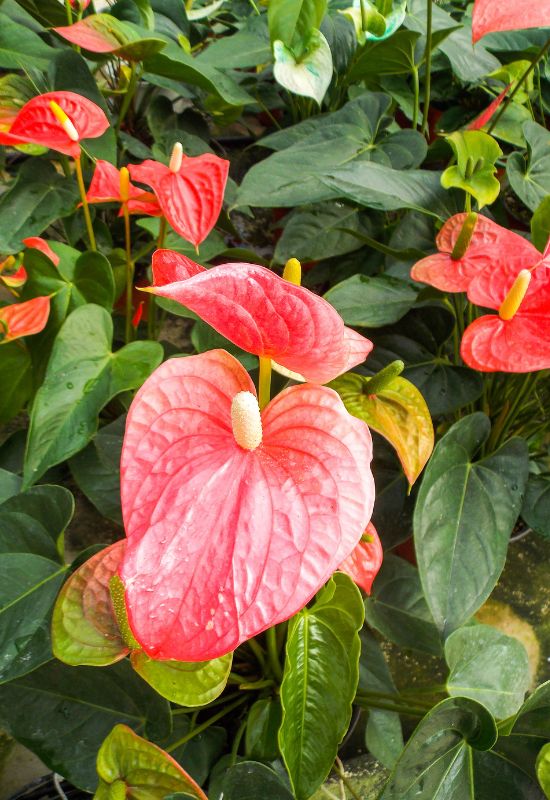
Anthuriums, or flamingo flowers, are usually grown as houseplants; but – hear, hear! – there is no reason why you can’t grow it in a garden – if, again, you live in a hot region… Well, in any case, indoors or outdoors, it will give you its amazing floral displays all year round!
What wows you of this perennial is actually the spathe, which looks like it’s a wax seal, or a little work of art in shiny ceramic… Usually white or red, and heart shaped, there are also varieties on the pink and rose scale, and even rare looking ones in maroon or almost black!
The blossoms are about 6 inches long (15 cm), and the central spadix may be gold or cream. But this exotic wonder and winner of the famous Award of Garden Merit by the Royal Horticultural Society also has very decorative foliage…
Smooth and semi glossy and rich green in shade, they can be ovate or arrow shaped, but always lush looking, like in a tropical forest!
Anthuriums require a warm and humid place to thrive outdoors, so, they are more suitable to southern states on East Coast, where it will look great in shady flower beds in tropical gardens. Alternatively, you can still grow it as a houseplant, like most people do…
11: Urn Plant (Aechmea fasciata)
Native of Brazil, where it’s summertime all year round, urn plant will blossom at any time, and its amazing floral display will last for months on ends, but it will only do it once, and then it will die… Still, it is really worth it!
The actual flowers are violet blue in color, like in other bromeliads, and they are quite pretty in themselves… But they also open in a pineapple like tuft of leaves that set them of wonderfully well, because they turn bright pink!
The effect is one of a massive bloom and a permanent one as well… All this will spike above a very sculptural rosette of pointed and arching leaves, like tough blades, green in color, but covered in a thin icing that makes them look bluish or silver…
Most of us will grow an urn plant indoors, as a houseplant, but you can have it outdoors in very hot climates (there’s a pattern here)… When the bloom starts, it will also start producing offsets at the base, which you can use to propagate it…
If you grow urn plant indoors, you can enjoy its long lasting bloom as a magnificent centerpiece, outdoors, you will need a very exotic looking garden, or a Mediterranean one, in flower beds or containers.
12: Agave (Agave spp.)
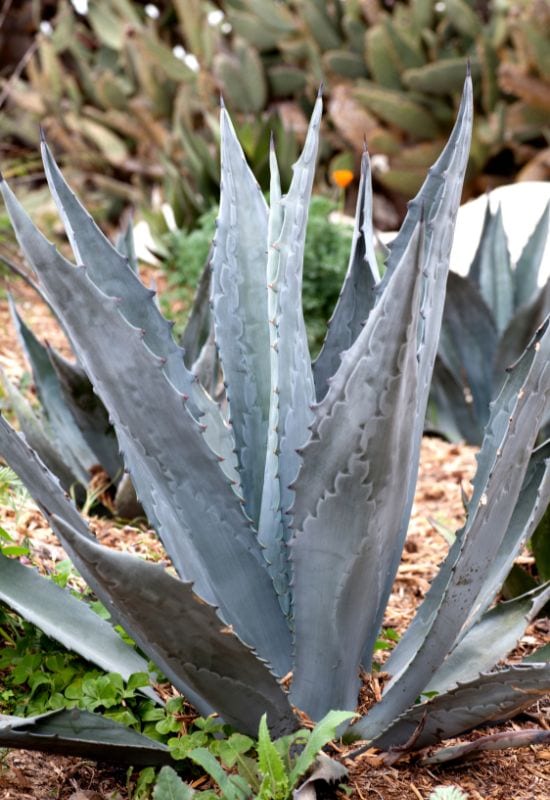
Here’s another monocarpic perennial, like urn plants, and like them, it will only bloom at the end of its life, but at any time of the year and for a very long time… And we all know what this means…
That huge and tall stem that suddenly shoots up into the sky (called a “quiote”)… Some varieties will stop just above your head, others will almost touch the clouds… And then… On top of it, loads and loads of flowers, often held on beautiful branches like in Japanese paintings or bonsais, like golden tufts of grass that blossom in the air…
Awe inspiring and sublime, this amazing spectacle will demand some patience though… You should expect to wait between 6 and 30 years to enjoy it, depending on the variety…. But during all this time, the amazing rosettes of pointed leaves, often variegated, and always extremely sculptural will turn your garden into a living art gallery!
There are so many different varieties of agave that it’s hard to choose one… Some are small, and more suitable to “normal” gardens, others grow colossal (and careful when the quiote falls – it is dangerous indeed) and they need a large space. All, however want hot and dry growing conditions…
13: African Violet (Saintpaulia spp.)
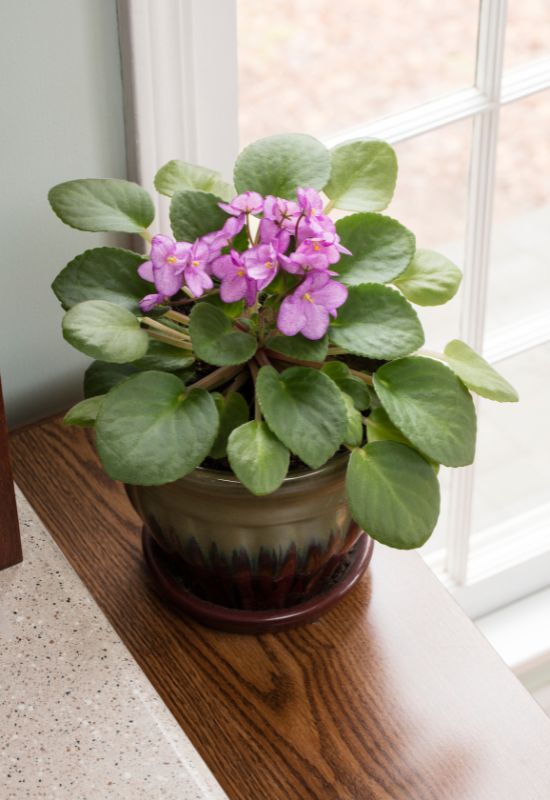
From the sunniest continent of all, African violets are loved all over the world, also because they can blossom all year round… They usually keep going for 10 months, but sometimes even 12!
And they look lovely and sweet… With their velvet petals round and sweet, forming charming bouquets that look up to you like children’s eyes, and in such vibrant colors! Violet and blue may be the most common, but you can have white, pink, red and even bicolor varieties as well!
What is also very attractive is that the buds nod down, but they straighten up when they bloom… All this will happen on a bed of soft looking, fleshy and ovate foliage, forming a rosette at the base of the plant, bright to dark green and with a fuzzy surface…
And this look and personality is not deceiving, Saintpaulia is a very tender plant, that needs some tender loving care to thrive.
Yet again, African violets are mainly grown as houseplants, but in a warm country you can also enjoy their soft and colorful presence in outdoor containers, flower beds and in rock gardens, where they really look enchanting!
14: Red Ginger (Alpinia purpurata)
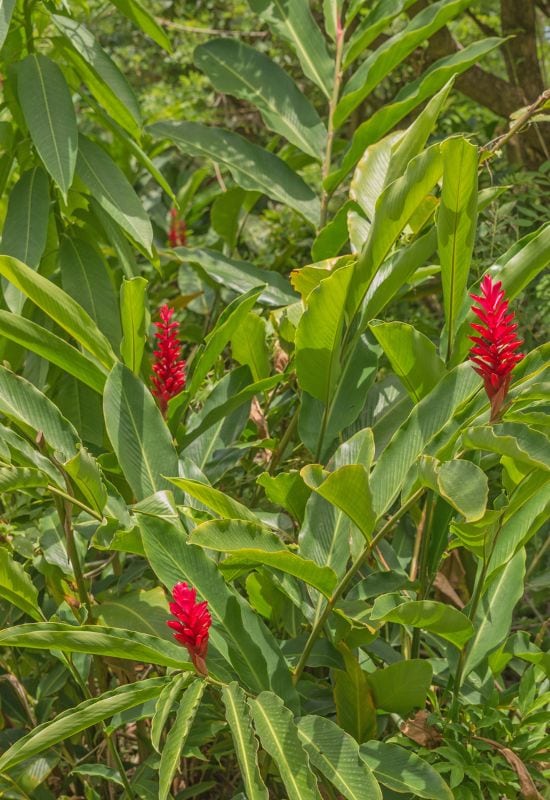
A close relative of common ginger from Malaysia red ginger can blossom at any time of the year, and it will really wow you! They look like red plumes that rise from the base of the plant, in shades from scarlet to amaranth, also similar to pagodas in many ways…
These are very glossy, almost like made of wax, and they look like burning flames that last for a long time in your garden. Each inflorescence can be about 12 inches long (30 cm). They are followed by small fruits, which ripen to a ruby tonality….
And even the leaves have a very exotic touch, lush, long, bright green and glossy, they form massive clumps, as each can be up to 32 inches long (80 cm).
Of course, red ginger is a plant that needs proper setting for its super showy blooms and tropical forest looking leaves… If you have an exotic garden (and climate), then you are in luck!
15: Bromeliads (Bromeliaceaefamily)
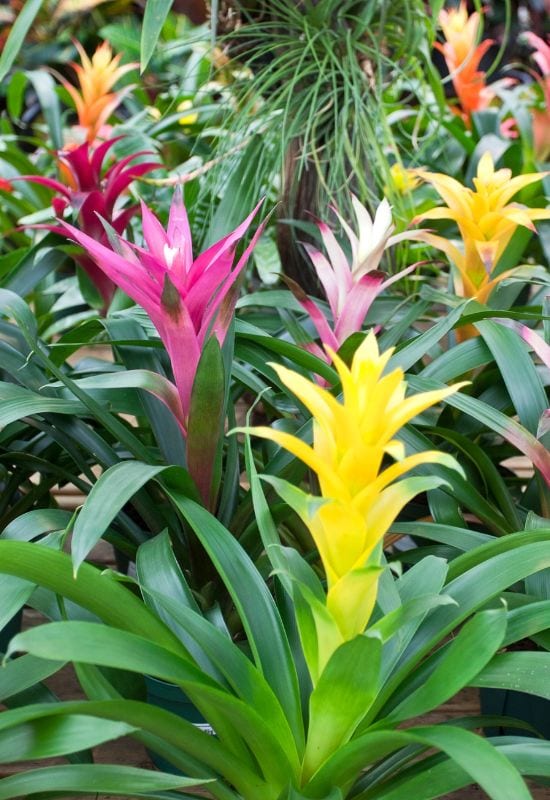
Most bromeliads come from the tropical Americas, and one from Africa, where there are no seasons as we mean them… And for thus reason, they may bloom at any time of the year, and they will keep going for a very long time indeed!
There are about 3,700 species, so, you can imagine that you do have a very wide choice, and we cannot look at them one by one. Usually grown as houseplants, they will add a special twist to their blossoms…
The flowers are usually quite brightly colored (mainly blue or violet – but not only), true… But the fact is that they also modify the leaves around the blooms and these become of the most amazing shades of red, pink, orange and yellow ever!
You could call it a trompe l’oeil effect, but still it is fantastic! And the rosettes at the base, with glossy and fleshy leaves, again, in different tonalities, are another great selling point for the members of this family…
Once they have flowered, they will actually wilt and die, but you can propagate them from the offsets they produce at the end of their lives. So, no need to buy new ones when your wait is over and your bromeliad explodes with colors!
Very common as houseplants, bromeliads will grow well outdoors in a tropical garden, if you can afford the right levels of humidity, water and heat at the same time. Otherwise, grow them in a pot and take them out during the warm season, then shelter them in winter…
16: Nasturtium (Tropaeolum majus)
Nasturtium is a spreading and sprawling short lived perennial, but it is usually grown as an annual, and it can blossom at all times of the year, but with a particular behavior…
Its flower shaped flowers, usually about 2 to 3 inches wide (5.0 to 7.5 cm) will come to your garden in winter and spring if you live in a mild country. If instead you live in a colder region, they will open in summer and fall.
If you are lucky, you will enjoy them throughout the year… And these flowers have the most vibrant shades of yellow, orange or red, and they have a distinctive fragrance, which is described as very refreshing….
These colorful blooms will pop out form a dense and soft looking round leaves, technically called orbicular, bright green or sometimes with pale bluish shades… And the whole plant is edible as well!
Ideal for ground cover, nasturtiums can also suit flower beds, rock gardens or for edging, but gardeners also love them on banks and slopes, where their fresh presence is a real asset.
17: Red Torch Ginger (Etlingeraeliator)
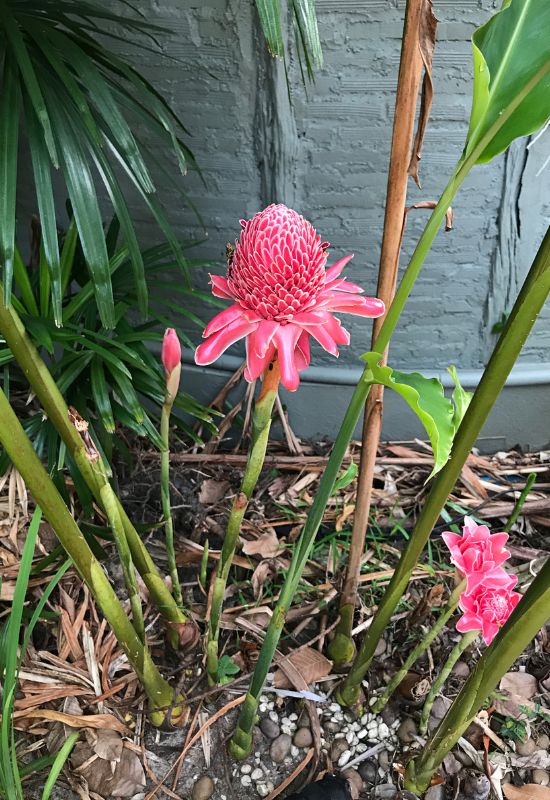
Get ready to be blown away! This amazing perennial native of Indonesia and Malaysia is a real giant… Let’s start with the bloom…. Of course, you nay see it at any time of the year, or it would not have made it into our list, but any time, it will be an incredible experience…
The huge blossom with waxy petals with a big dome in the middle can reach 12 inches across (30 cm)! And you will see folded petals at the margins that create a crown around it… Well, it looks like a flying saucer… But what you see is not what you think…
These are actually bracts that surround the real flowers, and these can be bright red to pink… And all this amazing floral spectacle comes on an upright and tall stem, that brings it almost to eye level, all from an underground rhizome. From there, it will also grow huge leaves, about 3 feet long (90 cm) and with a leathery texture and shiny green surface!
Having a red torch ginger plant in your garden is a fabulous experience, but you will need to give it a very important place in an exotic looking space – and, of course, lots of warm weather…
18: Star Jasmine (Trachelospermum jasminoides)
Seas of white flowers with the most beautiful fragrance in the world, so strong and heady that your neighbors will smell it too… And virtually all year round!
This is what you get if you grow this fabulous shrubby climber of star jasmine in your garden… Yes, it will take some small pauses, especially when it gets too hot, but even during these breaks, you may see a few blooms popping up.
The main spectacle will be in spring, where an incredible number of star shaped blossoms, each about 1 inch across (2.5 cm), may make you think that it has actually snowed, because the whole plant turns white!
But, as we said, star jasmine will also blossom at other times, even if sporadically. But you shouldn’t worry, because this marathon bloomer also has lovely evergreen foliage. The glossy and oval leaves are dark green most of the time.
However, they emerge with bronze tonalities and they turn reddish in fall… This amazing show for all the seasons has eared it the prestigious Award of Garden Merit by the Royal Horticultural Society.
Grow it on a strong trellis it pergola, let star jasmine climb over walls, or drape your gate, and you will have color and the most amazing fragrance all year round. It is a classic in Mediterranean gardens, but it will suit any informal style in a warm region.
19: Lemon Tree (Citrus x limon)
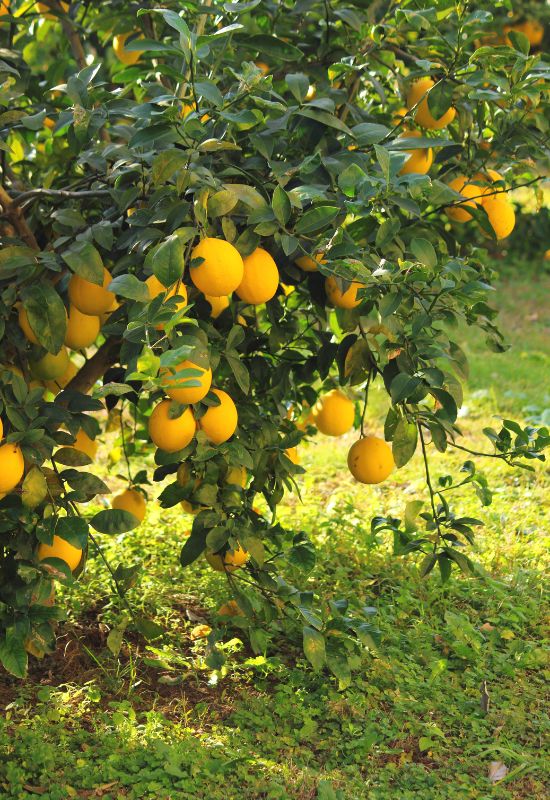
I am sure that by now you got the idea that Mediterranean gardens are never without blooms, and here is a classic again: lemon trees… Yes, these amazing beauties can literally blossom all year round…
As long as temperatures do not drop under 55oF, or 12oC, you will see its beautiful, scented and star shaped blossoms even in winter!
Its floral display caries throughout the year, and you may get gaps in it, but there is no actual season for them. And in fact, you will see them on the branches together with the fruits!
It’s hard to say what is more beautiful, if the golden yellow lemons or the blossoms, which are white but often with purplish blushes… With a lovely round crown, it also has very attractive foliage. And evergreen. The broad and pointed leaves are bright emerald green, almost leathery and glossy as well!
Lemon trees are also quite small, and you can grow them under bigger ones… What is more, even in Mediterranean gardens, people like to grow them in containers, so, in case you garden is not in a hot region, you can shelter it over winter.
20: Air Plants (Tillandsia spp.)
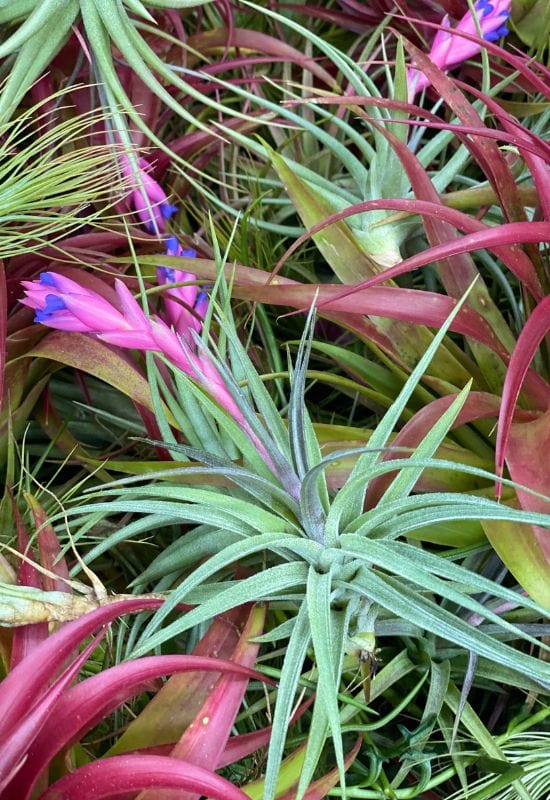
…And we conclude with a very original little jewel: Tillandisa, or air plant is a genus from Central and South America which can blossom at any time of the year, and for a very long time indeed.
In fact, it is another monocarpic variety, like agave or bromeliads… And in fact it belongs to thee same family of the latter, and you will spot it from the floral display…,the long, tubular flowers are actually blue or violet, often with a golden yellow crown at the end…
But these strangely behaved perennials also change the top leaves to the most amazing colors ever… There you will see amazing pinks, oranges, reds and yellows!
Because the foliage is long and pointed, like the arms of an octopus, you get an amazing effect, like little flames forming spectacular rosettes…
But this disheveled beauties are famous for another reason, and it’s all in the name… Yes, they literally grow in the air and they do not need soil at all!
Loved as houseplants, air plants are often attached to rocks or grown in shells, but thunk about having one or a good few in your garden as well…
A rockery would be perfect for it or them, but even an exotic and even weird looking flowerbed could host them, or how about on the branches of a tree?
Great Flowers for Spring, Summer, Fall and Even Winter – All Year Round!
Aren’t these plants amazing? Not only do they blossom at any time of the year… They are gorgeous in all!
Wonderful flowers, lush foliage, sweet or strong personalities, and amazing colors, for every season, for every day, basically, these are the long distance champions of the gardening world!
True, you will need a warm garden to grow them, but you can also have some of them indoors, or some time at home, and some time outside in the open air!

Written By
Amber Noyes
Amber Noyes was born and raised in a suburban California town, San Mateo. She holds a master’s degree in horticulture from the University of California as well as a BS in Biology from the University of San Francisco. With experience working on an organic farm, water conservation research, farmers’ markets, and plant nursery, she understands what makes plants thrive and how we can better understand the connection between microclimate and plant health. When she’s not on the land, Amber loves informing people of new ideas/things related to gardening, especially organic gardening, houseplants, and growing plants in a small space.

